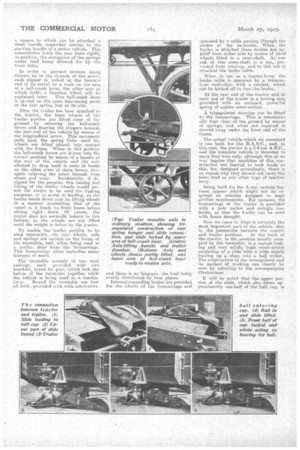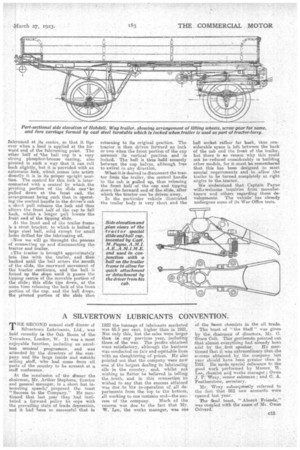THE TRACTOR-LORRY; INCREASING ITS SCOPE.
Page 13

Page 14

Page 15

If you've noticed an error in this article please click here to report it so we can fix it.
First Published Details of an Entirely New Vehicle Which can be Used Either as a Tractor-lorry or as a Tractor and Trailer.
Pr HE TRACTOR-LORRY has already proved itself to be a most useful type ofmachine, for it can transport very heavy loads, utilizing a power unit Which, if employed on a single vehicle of the ordinary type, would, owing to the limits imposed on axle weights, he able to deal only with loads of approximately half the weight. At tho same time, although such a vehicle is of considerable length, its manoeuvrability is not, reduced, because the tractor is flexibly connected to the trailer portion. In spite of the successes which have already been achieved, however, we have always believed that there is ample scope for improvement. In most tractor-lorries the flexibility Is all that can be desired for the vertical and horizontal relative movements between the tractor and trailer units, but in very few is account taken of twisting stresses, with the result that the turntables, and particularly the king-pins, have to withstand. great loads ; there is also a tendency to twist the frame of the trailer portion, causing racking Of the body. Such tacking can easily be seen if the Vehicle is crossing at an angle a road in which the camber is considerable, where the tractor portion is at one side ,of the camber and the trailer at the other.
In the British designs, also, few at-. tempts have been made to render the
trailer portion practicable for use as a separate trailer—i.e.; bythe provision of wheels at the front end. In certain
foreign designs, such wheels are. embodied, but they are, in the main, small and hardly equal to work other than that of' permitting the trailer portion to be wheeled about in yards, etc. In the type of vehicle invented by Captain M. Rayne, A. MI. A.E., A.M,L1Nfech.B., of Hobdell, Way and Co. Ltd., The Hyde, Hendon, London: W N..9, we found many new features of very considerable interest, which would seemingly greatly increate the scope of the tractor-lorry and, at the same time, overcome some of the inherent faults which have shown themselves in certain of these machines.
The 'crux of the invention lies in the method-of attachment of trailer to tractor. This has been so devised that the tractor can be attached or detached by the driver without having to leave his seat, and without requiring the services of a second man.
The trailer portion, -when detached, forms a unit running on four wheels of . the same size, of which those at the front are carried on an ordinary axle with underslung springs, each of which is connected at its ends to long links pivoted to the trailer frame, These links are not vertical, but swing away from the axle at the lower ends.
On the spring pin of each of the inner links is carried an arm, which is pivoted at its upper end to a_slipper running on a slide attached to the bottom of a side member of the trailer frame. The two slippers are connected by a triangulated frame at the apex of which is a nut running on a horizontal and longitudinal screw, which is produced to the rear end of the. trailer unit and ends in a square to -which can be.attached a stout handle somewhat similar to the starting handle of:a motor vehicle. This construction holds the rear links rigidly in position, the elongation of-the springs under load being allowed for by the front links.
In order to prevent stresses being. thrown bn to the threads of the screw. each -slipper is locked at the forward end of its travel by a hook on one aria of a bell-crank lever, the other arm of which fulfils• a function which will be explained later. This bell-crank lever is carried on thesame fulcruming points as the rear spring link at its side.
After the trailer has been attached to the tractor, the front wheels of the trailer portion axe lifted clear of the ground by releasing the bell-crank 'levers and drawing the slippers towards the rear end of the vehicle by meafts of the longitudinal screwThis movement. pulls back the spring links until the wheels are lifted almost into contact-with the frame. When in this position the bell-crank levers are drawn into the correct position by means of a handle at the rear of the vehicle and the axle allowed to drop until it rests in hooks on the other arms of these levers, thes again relieving the screw threads from
stress and wear. Incidentally, if de signed for the purpose, this raising and lifting -of the trailer wheels wonld permit the trailer to be used for tipping purposes, or to assist in loading, as the trailer bends down over its lifting wheels in a. manner resembling that of the camel as it bends its front knees before sitting right_ down.Of course, the trailer does not normally behave in this fashion; as the wheels are not lifted until the weight is taken by the tractor.
To enable the trailer, portion to be used separately, the 'rear wheels, axle and springs are carried on the frame of the turntable,. and, when being used as a • trailer, they form the forecarriage. This forecarriage elope embodies many features of merit, The turntable consists of two steel castings, each provided • -with two brackets, bored for pins, which lock the halves of the turntable together while the vehicle is being used as a tractor iorry. Round the turntable are four oil wells.-provided with wick lubricators, and there is no king-pin, the load being evenly distributed by four plates. Internal-expanding brakes are provided for the wheels of the forecarriage and operated by a cable passing through the centre ef the turntable. When the trailer is attached these -brakes are applied from either side by means of hand wheels fitted to a cross-shaft. At one end of this cross-shaft is a nut, prevented from rotating, and to this nut is attached the brake cable.
When in use as a tractor-lorry, the brake cable is operated by a tramcartype controller, with a ratchet, which can -be kicked off to free the brake.
At the rear end of the tractor and at each end of the trailer is a towing eye, provided with an enclosed, powerful spring of square cross-section.
A tria,pgulated drawbar can be fitted tothe forecarriage. This is automatically kept clear of the ground by means: of springs, and when not required is stowed away wilder the 'bent end of the
frame. • The actual vehicle .which we examined is one built for the R.A.S.C., and, in this case, the tractor is a 3-4-ton A.E.C., and the complete vehicle is intended to carry four tons only, although this in no way implies that machines of this construction are limited to such loads as this, for, designed accordingly, there is no reason why they should reot.carry tito same load as any other type of tractorlorry.
Being built for the Army, certain features appear which might not be required on vehicles designed to meet civilian eequirements. Fur instance, the forecarriage of the trailer is provided with a pole socket and swingle .tree looks, so that the teener can be .used with horse draught.
Now we come to what is certainly the most important part of the vehicle, that is, the connection between the tractor
and trailer portions. At the back of the tractor, in the, position usually Deellpied by the turntable; is a curious-looking and very solidly built constrtiction consisting of a slide with a wide mouth leading up a slope into a ball socket. The construction of the arrangement and its method of working can clearly be seenby referring to the accompanying illustrations.
It will be noted thet the_ upper portion of the slide, which also forms approximately one-half of the ball cup, is
fulcrumecl at its centre, so that it tips over when a load is applied at the forward end of the fulcruming point. The other .half of the ball cup is a very strong phosphor-bronze casting, also pivoted in such a way that it can roll back slightly, but it is providect -with an automatic lock, which comes into action directly it is in its proper upright position. The control for this lock is interconnected with a control by which, the pivoting portion of the Aide can be pulled' down at the front end, the arrangement being such that in operating the control handle in the driver's cab a, -short pull releases the lock and thus allows the front half of the cap to :fall back, whilst a longer mill lowers the front end of the tipping slide.
At the front end of the trailer frame is a stout bracket, to Which is bolted a large steel ball, solid except for small holes drilled for the lubricating ail.
'.Now we will go throught the. process of connecting up and disconnecting the tractor and trailer.
The tractor is brought approximately into line with the trailer, and then banked until the ball enters the mouth of the slide, the rearward movement of the tractor continues, and the ball is forced up the slope until it passes the tipping centre of the movable portion of the slide; this slide tips down, at the same time releasing the lock of the front portion of the cup, and the ball drops, the pivoted portion of the sfide then returning to its original position. The tractor is then driven forward an inch or two when the front portion of the cup assumes its vertical position and •is locked. The ballis thus -held -securely between the cup halves, although free to.swivel in any direction; When it is desired to disconnect the tractor f rein the trailer, -the control handle in the 'cab is pulled up., thus releasing the front half •of the cup and tipping down the ;forward end-of the. slide, after which the tractor can be driven away.
In the particular vehicle illustrated the trailer body is very short and the
ball socket rather fur back, thus. considerable space is left between the back of the cab and the front of the trailer, but there is no reason why this could not be-reduced considerably in building other models, for.it.must be remembered that this has been designed to meet special requirements and to allow the trailer to be turned completely at right angles to the tractor.
We understand that Captain Payne will welcome inquiries from manufacturers and others regarding these developments. The vehiclehas already undergone some of its War Office tests.






























